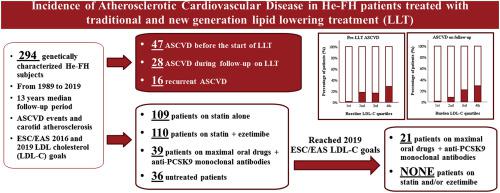当前位置:
X-MOL 学术
›
Atherosclerosis
›
论文详情
Our official English website, www.x-mol.net, welcomes your
feedback! (Note: you will need to create a separate account there.)
Long term follow-up of genetically confirmed patients with familial hypercholesterolemia treated with first and second-generation statins and then with PCSK9 monoclonal antibodies
Atherosclerosis ( IF 4.9 ) Pub Date : 2020-09-01 , DOI: 10.1016/j.atherosclerosis.2020.07.006 Andrea Pasta 1 , Anna Laura Cremonini 1 , Elena Formisano 1 , Raffaele Fresa 2 , Stefano Bertolini 1 , Livia Pisciotta 2
Atherosclerosis ( IF 4.9 ) Pub Date : 2020-09-01 , DOI: 10.1016/j.atherosclerosis.2020.07.006 Andrea Pasta 1 , Anna Laura Cremonini 1 , Elena Formisano 1 , Raffaele Fresa 2 , Stefano Bertolini 1 , Livia Pisciotta 2
Affiliation

|
BACKGROUND AND AIMS
In Italy, the clinical and genetic characteristics of familial hypercholesterolemia (FH) have been extensively assessed in various lipid clinics, although no studies on long-term cardiovascular outcomes in heterozygous patients (He-FH) have been conducted. This study evaluated the incidence of atherosclerotic cardiovascular disease (ASCVD) in He-FH before and after a long-term period of lipid-lowering treatments to ascertain the interference of other risk factors. METHODS
A total of 294 genetically characterised He-FH subjects from 1989 to 2019 were retrospectively analysed. General characteristics, lipid profiles, ASCVD prevalence, and ultrasound carotid atherosclerosis assessment were evaluated. Primary end points were ASCVD outcomes and the percentage of patients reaching recommended LDL-C targets. RESULTS
During follow-up, despite a significant improvement in plasma lipid profiles, the ESC/EAS 2016 and 2019 recommended LDL cholesterol (LDL-C) goals were attained in only a few patients treated with anti-PCSK9 monoclonal antibodies added to the maximum tolerated oral therapy with statins plus ezetimibe. Forty-seven subjects had an ASCVD event before starting lipid-lowering therapy (LLT). During follow-up (median 13 years) on LLT, 28 patients had a first ASCVD event and 16 had recurrent ASCVD. In basal conditions and during follow-up, higher LDL-C levels were associated with increased ASCVD risk (p < 0.001). Prevention of recurrent ASCVD events was recorded with a long-term reduction of LDL-C below 100 mg/dl with statins plus ezetimibe. CONCLUSIONS
PCSK9 inhibition is the only therapeutic option to achieve LDL-C goals as recommended for He-FH and can prevent ASCVD events as reported in large clinical trials. Long-term treatment with statins and ezetimibe seems to be effective at preventing ASCVD recurrence when LDL-C is maintained below 130 and 100 mg/dL for primary and secondary prevention, respectively.
中文翻译:

对基因确诊的家族性高胆固醇血症患者接受第一代和第二代他汀类药物治疗,然后使用 PCSK9 单克隆抗体进行长期随访
背景和目的 在意大利,家族性高胆固醇血症 (FH) 的临床和遗传特征已在各种脂质诊所进行了广泛评估,但尚未对杂合子患者 (He-FH) 的长期心血管结局进行研究。本研究评估了长期降脂治疗前后 He-FH 中动脉粥样硬化心血管疾病 (ASCVD) 的发生率,以确定其他危险因素的干扰。方法 回顾性分析了 1989 年至 2019 年共有 294 名具有遗传特征的 He-FH 受试者。评估了一般特征、脂质特征、ASCVD 患病率和超声颈动脉粥样硬化评估。主要终点是 ASCVD 结局和达到推荐 LDL-C 目标的患者百分比。结果 随访期间,尽管血浆脂质谱显着改善,但只有少数接受抗 PCSK9 单克隆抗体治疗的患者达到了 ESC/EAS 2016 和 2019 推荐的 LDL 胆固醇 (LDL-C) 目标,并加入了他汀类药物和依折麦布的最大耐受口服治疗. 47 名受试者在开始降脂治疗 (LLT) 之前发生了 ASCVD 事件。在 LLT 的随访期间(中位 13 年),28 名患者出现了首次 ASCVD 事件,16 名患者出现了复发性 ASCVD。在基础条件下和随访期间,较高的 LDL-C 水平与增加的 ASCVD 风险相关(p < 0.001)。通过使用他汀类药物加依折麦布将 LDL-C 长期降低至 100 mg/dl 以下,记录了对复发性 ASCVD 事件的预防。结论 PCSK9 抑制是实现 He-FH 推荐的 LDL-C 目标的唯一治疗选择,并且可以预防大型临床试验中报告的 ASCVD 事件。当用于一级和二级预防的 LDL-C 分别维持在 130 和 100 mg/dL 以下时,他汀类药物和依折麦布的长期治疗似乎可有效预防 ASCVD 复发。
更新日期:2020-09-01
中文翻译:

对基因确诊的家族性高胆固醇血症患者接受第一代和第二代他汀类药物治疗,然后使用 PCSK9 单克隆抗体进行长期随访
背景和目的 在意大利,家族性高胆固醇血症 (FH) 的临床和遗传特征已在各种脂质诊所进行了广泛评估,但尚未对杂合子患者 (He-FH) 的长期心血管结局进行研究。本研究评估了长期降脂治疗前后 He-FH 中动脉粥样硬化心血管疾病 (ASCVD) 的发生率,以确定其他危险因素的干扰。方法 回顾性分析了 1989 年至 2019 年共有 294 名具有遗传特征的 He-FH 受试者。评估了一般特征、脂质特征、ASCVD 患病率和超声颈动脉粥样硬化评估。主要终点是 ASCVD 结局和达到推荐 LDL-C 目标的患者百分比。结果 随访期间,尽管血浆脂质谱显着改善,但只有少数接受抗 PCSK9 单克隆抗体治疗的患者达到了 ESC/EAS 2016 和 2019 推荐的 LDL 胆固醇 (LDL-C) 目标,并加入了他汀类药物和依折麦布的最大耐受口服治疗. 47 名受试者在开始降脂治疗 (LLT) 之前发生了 ASCVD 事件。在 LLT 的随访期间(中位 13 年),28 名患者出现了首次 ASCVD 事件,16 名患者出现了复发性 ASCVD。在基础条件下和随访期间,较高的 LDL-C 水平与增加的 ASCVD 风险相关(p < 0.001)。通过使用他汀类药物加依折麦布将 LDL-C 长期降低至 100 mg/dl 以下,记录了对复发性 ASCVD 事件的预防。结论 PCSK9 抑制是实现 He-FH 推荐的 LDL-C 目标的唯一治疗选择,并且可以预防大型临床试验中报告的 ASCVD 事件。当用于一级和二级预防的 LDL-C 分别维持在 130 和 100 mg/dL 以下时,他汀类药物和依折麦布的长期治疗似乎可有效预防 ASCVD 复发。
















































 京公网安备 11010802027423号
京公网安备 11010802027423号